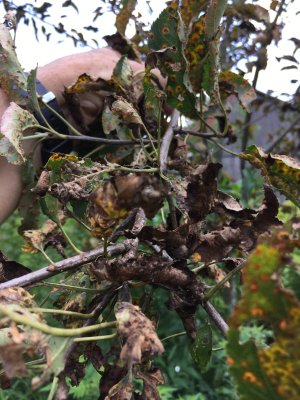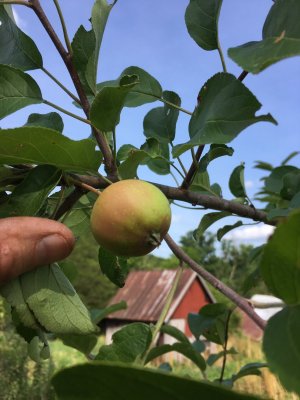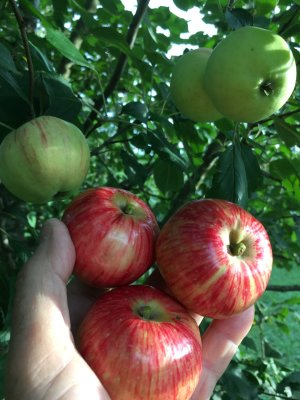Red Cedar is the culprit, not white cedar. I have no known red cedar within miles of me and have very little CAR even on susceptible varieties like Shizuka. If you have red cedars around avoid the susceptible varieties.
Cedar Apple Rust (Gymnosporangium juniperi-virginianae Schwein.)
By David Taylor
This fungus is wide spread in eastern North America. It is usually associated with rural areas that alternate between farmland and forest or thicket. It requires two hosts to be present, usually within a mile of each other, a juniper species, usually eastern redcedar (Juniperus virginiana), and an apple, crabapple (Malus or Pyrus spp. depending on source), hawthorn (Crataegus spp.) or quince (Cydonia oblonga). The fungus takes on different forms on each host and most readily noticeable on redcedar. One form or another of the fungus can be can be found throughout the growing season, but may not be seen in drier sites until after a series of rains. It frequently is found in disturbed or open areas such as along gravel or dirt roads, trails openings, pastures and apple orchards.
Cedar apple rust is a member of the family Pucciniaceae, a group of fungi that contains many species that usually require two or more hosts to complete the life cycle. Members of this family are known as rusts because the color of many is orange or reddish at some point in the life cycle. Many rusts are disease agents of crop plants including black stem rust of wheat, soybean rust and white pine blister rust. From three to five different spore types are produce by rusts, but one is always a basidiospore. These spores are produced on structures called basidia place the family is in the Basidiomycota, a large group that includes many common mushrooms. Large infestations of this rust can reduce yield on apples, blemish the fruit, and lead to weakening and death of redcedar.
This particular rust produces four kinds of spores: basidiospores, teliospores, spermatia, and aeciospores. Teliospores are produce on gelatinous telial horns (see photo) which originate from golf ball-like growths on redcedars or other junipers. Telial horns emerge following a warm spring rain in April to May. Five to seven sets of teliohorns can be produced during spring, one after each warm rain. Teliospores germinate to form basidia. Basidia produce basidiospores that are released into the air, blown two to three miles potentially to an apple or hawthorn leaf or fruit. They germinate and form a yellow to orange spot on the leaf or fruit (see photo). These spots produce spermogonia that in turn produce spermatia. The spermatia are released into a sticky liquid attractive to many insects. As insects carry spermatia from one spot to the next fertilization takes place. The fungus grows through the leaf and produce aecia on the underside of the leaf (see photo). The aecia produce aeciospores that are windblown back to the redcedars. They then germinate and start the formation of galls that in the following year will produce telial horns to start the process over again.








